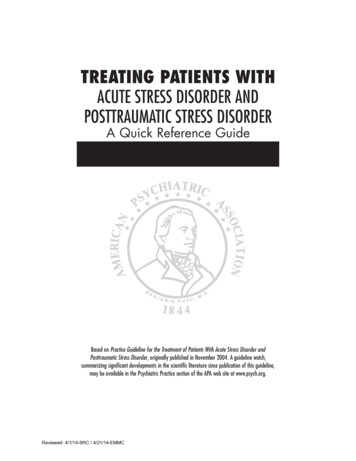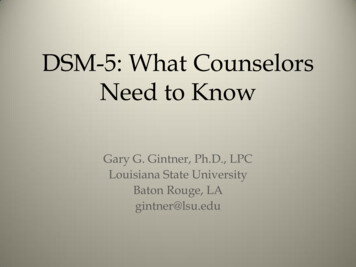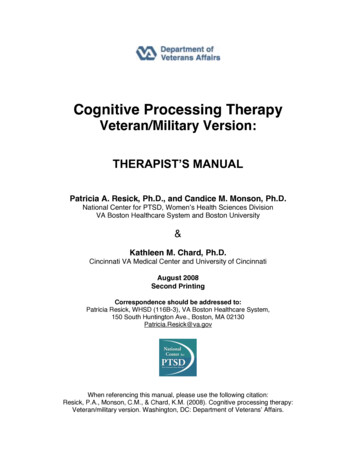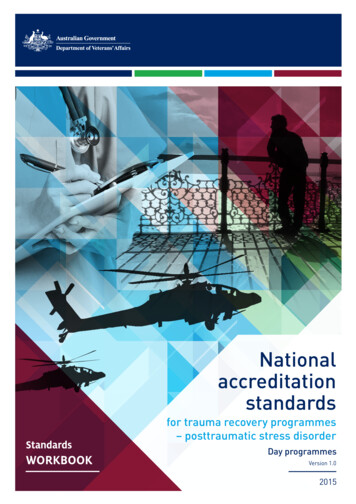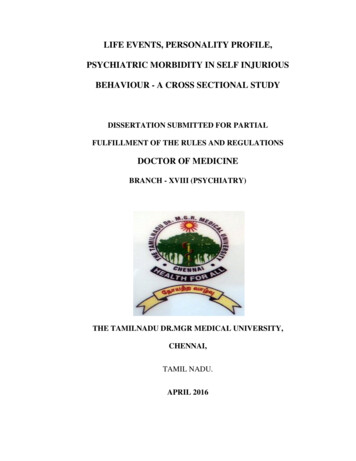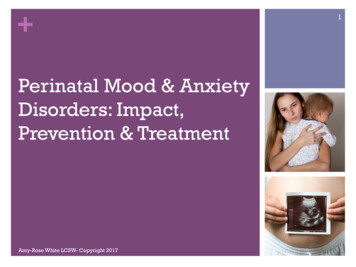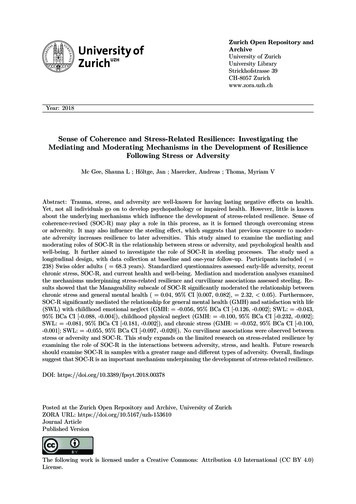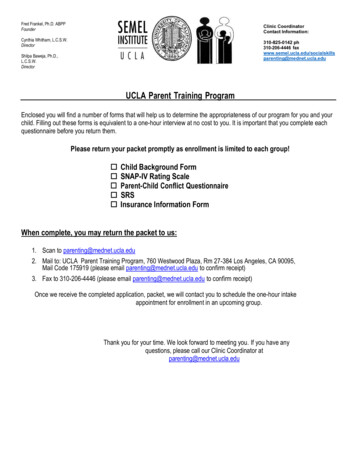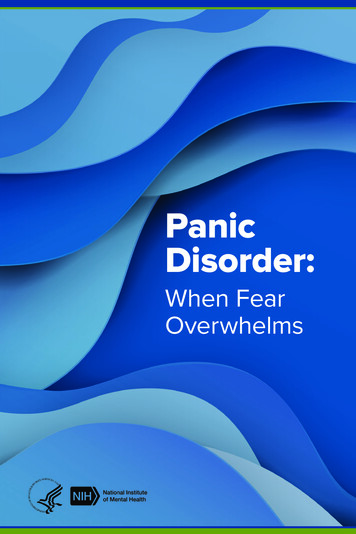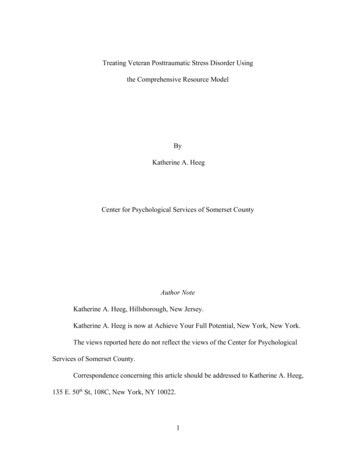
Transcription
Treating Veteran Posttraumatic Stress Disorder Usingthe Comprehensive Resource ModelByKatherine A. HeegCenter for Psychological Services of Somerset CountyAuthor NoteKatherine A. Heeg, Hillsborough, New Jersey.Katherine A. Heeg is now at Achieve Your Full Potential, New York, New York.The views reported here do not reflect the views of the Center for PsychologicalServices of Somerset County.Correspondence concerning this article should be addressed to Katherine A. Heeg,135 E. 50 th St, 108C, New York, NY 10022.1
Email: Kathy@AchieveYourFullPotential.netAbstractThe Comprehensive Resource Model is a groundbreaking new psychotherapeutictreatment modality with broad possibilities for use with the military veteran population.Objective: This article describes in detail a clinical case example where this modality wasused with a military veteran presenting with severe PTSD symptoms. Method: Six 60-75minute treatment sessions with the veteran are described, and client symptoms weremeasured before and after treatment and at a two year follow up using the PosttraumaticDiagnostic Scale, Hospital Anxiety and Depression scale, and Clinical Global Impressionscale. Results: F indings showed that the treatment was effective at relieving the worstsymptoms (dissociation and flashbacks) even after two years. Some symptoms remainedsuch as hypersensitivity to loud noises. Conclusion: The Comprehensive ResourceModel, specifically the Resource Energy Grid, provided a safe, effective way to treatsome of the most challenging symptoms in trauma therapy. Studies on larger samplesizes would be necessary for generalizability. An Appendix by the spouse of the subjectprovides additional support for the findings.Keywords: Comprehensive Resource Model, combat PTSD, dissociation, ResourceEnergy Grid2
The purpose of this article is to introduce the Comprehensive Resource Model ofpsychotherapy with a clinical case study. The Comprehensive Resource Model wasformerly called the Resource Model of Brainspotting. To date, no articles or books havebeen written specifically about this model in the professional literature. This case reportattempts to test the effectiveness of the Comprehensive Resource Model, specifically aclinical tool called the Resource Energy Grid. Pre and post treatment questionnaires areused to measure results. This article attempts to show that the Comprehensive ResourceModel is a practical and effective therapeutic modality for treating Posttraumatic StressDisorder related to military service.The Comprehensive Resource Model is a new psychotherapy treatment forPosttraumatic Stress Disorder (PTSD) and Complex Posttraumatic Stress Disorder. It hassome similarities to the evidence-based treatment Eye Movement DesensitizationReprocessing (EMDR), and Brainspotting, a modality that uses focused eye position.While EMDR primarily uses eye movements, Brainspotting predominantly uses focusedeye positions. Corrigan and Grand (2013) define Brainspotting:Brainspotting is a psychotherapy based in the observation that the body activationexperienced when describing a traumatic event has a resonating spot in the visualfield. Holding the attention on that Brainspot allows processing of the traumatic3
event to flow until the body activation has cleared. This is facilitated by atherapist focused on the client and monitoring with attunement (p. 1).Grand (2010) further defines Brainspotting below.A "Brainspot" is the eye position which is related to the energetic/emotionalactivation of a traumatic or emotionally charged issue within the brain. Locatedby eye position, paired with externally observed and internally experiencedreflexive responses, a Brainspot is actually a physiological subsystem holdingemotional experience in memory form. Brainspotting stimulates and promotesdeep processing, integrating, and healing activity within the brain. This appears totake place within the brain’s emotional centers at a reflexive and cellular level. Ittypically results in a de-conditioning of previously conditioned, maladaptiveemotional, psychological, and somatic responses and patterns. It appears tostimulate, focus, and activate the body’s inherent capacity to heal itself fromtrauma.The Comprehensive Resource Model appears to take the above process evenfurther, adding another six nested, primary resources and four secondary resources whichare utilized sequentially, concurrently, or individually as needed throughout the therapywork . The use of these layered resources creates a streamlined, highly effective level ofsomatic resourcing and brain-based neurobiological rewiring. The component of the4
CRM model which was used as the primary resource in this particular case is theResource Energy Grid, during which a client identifies grounded, centered, present, solidareas of the body and connects them together, creating an internal resource, and fromthere, a corresponding eye position is found which anchors this state physiologically , andthe traumatic reprocessing work begins . Lisa Schwarz, M.Ed., developed theComprehensive Resource Model (Schwarz 2009). Brainspotting was used in her clinicalpsychology practice with clients diagnosed with Dissociative Identity Disorder (DID) andDissociative Identity Disorder Not Otherwise Specified (DDNOS), and theComprehensive Resource Model evolved out of her work with that population (Schwarz2009). An upcoming book The Comprehensive Resource Model for the treatment ofcomplex posttraumatic stress disorder is currently being written by Frank Corrigan andLisa Schwarz (L. Schwarz, personal communication, January 13, 2014).Working with Trauma and DissociationIn the DSM 5 diagnostic criteria for Posttraumatic Stress Disorder, exposure toactual or threatened death through directly experiencing the traumatic event is one waythe disorder might develop. Dissociative symptoms are considered “intrusion symptomsassociated with the traumatic event(s), beginning after the traumatic event(s) occurred”(DSM 5, 2013, p. 271). Recurrent distressing memories and dreams related to traumamay occur, or:Dissociative reactions (e.g., flashbacks) in which the individual feels or acts as if thetraumatic event(s) were recurring. (Such reactions may occur on a continuum,5
with the most extreme expression being a complete loss of awareness of presentsurroundings.) (DSM 5, 2013, p. 271).Robert Scaer (2004) coined the term “trauma capsule” to describe traumaticmemories held in the brain. The Comprehensive Resource Model attempts to resolve theproblem of trauma capsules. Scaer best describes dissociation within PTSD below.Dissociation has its roots in the procedural memories for remote traumatic events,and that the confusion between past and current events is the defining feature ofdissociation. Current thinking would suggest that when patients have dissociated,they are experiencing distorted perceptions in a variety of possible areas – reality,time, memory, sense of self, sense of the body, etc. In fact, what they areexperiencing are perceptions that have been stored in survival-based proceduralmemory as if they reflect the experience of the present moment. . . The primarydiagnostic criteria for PTSD reflect that posttraumatic symptoms to a significantdegree relate to abnormal memory processes – dreams, flashbacks, intrusivethoughts and images, cue-related anxiety and startle, avoidance of exposure toreminders of the trauma. Although the other important criteria for PTSD includearousal and avoidance criteria, one could make the case that the entire symptomcomplex of PTSD is based on the premise that an event that occurred in the past isperceived as a lived event that is still in the present. . . .trauma therefore could bedefined as a corruption of perception of time and memory. . . . The primaryfunction of procedural memory is the acquisition of information and skills that are6
necessary for survival. And most of these have to do with the unconsciousfunctioning of your body (p p. 2-3).Furthermore, implicit memories are stored in sensory form, while explicitmemories are stored in narrative form. Stress hormones adrenaline and cortisol (releasedduring attachment disruption or trauma) shut down the hippocampus, preventingintegration from implicit to explicit memory (Image 1). In Image 1, the circle containingbubbles represents the trauma capsules, or disturbing life experiences we accumulate overtime. The way we make a memory is similar to the way we digest food: our bodies takewhat is needed and then waste is eliminated. In order for a memory to “digest,” it mustprocess through the hippocampus, which is shown in the bottom center of Image 1.However, when a traumatic event is experienced, stress hormones adrenaline and cortisolare released, stopping the memory from being integrated into explicit memory, and thememory remains stuck in its sensory state form (Schwarz, 2009). With ComprehensiveResource Model therapy, traumatic memories are accessed through either eye position orbody activation and process through the hippocampus, releasing the disturbing aspects ofthe traumatic memory until it is no longer bothersome and can integrate intoautobiographical memory.7
Image 1A New ModelOne of the biggest challenges in treating the mental health symptom ofdissociation during trauma treatment is keeping clients grounded and supported whilereprocessing traumatic memories without becoming emotionally flooded, detached,ungrounded and “checked out” or dissociative. While other trauma therapies mightsuggest in their theoretical conceptualization that a client presenting with dissociativefeatures “is not ready” for trauma reprocessing work, the Comprehensive ResourceModel provides a safe, effective way to help clients reprocess traumatic memories. TheResource Energy Grid is a clinical tool that works like this: the therapist asks the client8
to direct his or her attention inward to the body and find a physical location that feelsgrounded, centered, solid, present; the client says “my feet feel okay;” then the therapistasks the client to identify grounded, solid, centered, present spot, and the client says “myknees” and the therapist instructs the client to draw an imaginary line on the inside of thebody connecting the feet up to the knees. In this manner, a series of seven “okay” spots,including an energy release spot , are linked together, even within people who often havemultiple somatic complaints. From there, the therapist assists the client in finding the eyeposition that corresponds with the felt sense of the connected points, or the grid as awhole. The client is invited to stay on this eye position while the trauma material isremembered, released, and re-processed. Comprehensive Resource Model clinicianshave found that by using this Resource Energy Grid as a tool, dissociative clients manageto stay present during therapeutic work and the majority do not decompensate aftersessions or between sessions during which they reprocessed deeply disturbing traumaticlife experiences . For clients who are unable to “find” any felt sense of somatic resourcesas building material for the grid, the use of other components of the CRM are mobilizedin order to allow for somatically dissociated clients to achieve success in terms ofdeveloping a conscious connection to their body.In the author’s experience, the Resource Energy Grid is an essential clinical tool.Without the use of this tool, the clinician can unintentionally trigger a client’s traumacapsule holding psychological pain. Clients can become emotionally flooded, feelunglued, and decompensate. This is the clinician’s equivalent to stepping on a landmine.9
The Resource Energy Grid provides an added safety feature: consider it the seatbelt fortrauma work.The Comprehensive Resource Model has clients evaluate their own distresslevels. This is accomplished through the Subjective Units of Disturbance scale (SUD),which was created by Joseph Wolpe (1969). This scale is used by therapists to evaluateclient distress levels and indicate client progression. Clients are asked, “On a scale ofzero to ten, with ten being the worst distress level imaginable and zero being no bother orneutral, how much does the traumatic incident bother you now?” During EMDRtreatment, the goal is to achieve a zero SUD score. Unlike EMDR, ComprehensiveResource Model clinicians might instruct the client to increase their SUD score as high asit will go by saying, “Close your eyes and go inside and think of the traumatic event anddo whatever you have to do to activate the distress level as high as it will go.” Whenneurobiological resources are identified and developed in the context of this high level ofdistress, before the actual processing begins, the power and effectiveness of theresourcing throughout the trauma work is assured. Repetition is required for learning anynew behavior, and it seems that by repeating this process, the new, more adaptive neuralpathways become strengthened.Single-Subject Design10
Single-subject designs have played an important role in the history of behavioralresearch. Reading an individual case study can be more tangible than abstract data froma larger study. Rubin and Babbie (1993) write:Significant scientific advances do not necessarily require the use of large-scale studiesthat attempt to verify hypotheses. Important contributions also can be made byexploratory studies that use more flexible methods, including smaller samples, inefforts to discover new insights and generate hypotheses and theories for whichgeneralizability can be tested later in more tightly controlled studies using larger,probability samples (p. 297).Pre-treatment, post-treatment, and follow-up assessments were administered bythe author. The assessment instruments used were: The Posttraumatic Diagnostic Scale(PDS; Foa, 1995); the Hospital Anxiety and Depression Scale (HADS; Zigmod & Snaith,1983); and the Clinical Global Impression (CGI), which is used to assess treatmentresponse in psychiatric patients. The questionnaires were given prior to the first session,at the fifth session, and two years following the conclusion of treatment.The Posttraumatic Diagnostic Scale, or PDS, is described below by Foa, E.,Cashman, L., Jaycox, L., & Perry, K. (1997).The PDS is a 49-item self-report measure recommended for use in clinical orresearch settings to measure severity of PTSD symptoms related to a single11
identified traumatic event. The PDS has four sections. Part 1 is a trauma checklist.In Part 2, respondents are asked to describe their most upsetting traumatic events. . . Part 3 assesses the 17 PTSD symptoms. Respondents are asked to rate theseverity of the symptom from 0 ("not at all or only one time") to 3 ("5 or moretimes a week / almost always"). Part 4 assesses interference of the symptoms.The PDS yields a total severity score (ranging from 0 to 51).The PDS has been validated on individuals aged 18-65 (Foa, 1995). Results were handscored by the author.The Hospital Anxiety and Depression Scale (HADS) was developed by Zigmondand Snaith (1983) and is commonly used by doctors to determine the levelsof anxiety and depression that a patient is experiencing not related to medical illness.The HADS is a 14 item scale; seven of the items relate to Anxiety (A) and seven relate toDepression (D). There are three categories for scoring the HADS: 0-7 Normal, 8-10 Borderline abnormal (borderline case), and 11-21 Abnormal (case).The Clinical Global Impressions scale (CGI) is a three item observer-rated scalecommonly used to measure symptom severity, global improvement, and therapeuticresponse. For this case study, only one of the three items was used, the CGIImprovement scale. This is a seven point scale that requires the clinician to assess howmuch the patient's illness has improved or worsened relative to a baseline state at thebeginning of the intervention and rated as: 1-significantly improved; 2-much improved;12
3-minimally improved; 4-no change; 5-minimally worse; 6-moderately worse; or7-significantly worse.Case ReportMark was a 29 year-old biracial married man who came to treatment after adisturbing dissociative episode. Mark served in the military for eight years; five yearsincluded active duty combat deployment overseas. Mark served in a leadership positionand received an honorable discharge. While deployed, Mark escaped some lifethreatening situations, but what was most difficult for him was assigning which of hisfellow soldiers went out on convoys. One of his comrades “didn’t make it back” andanother one lost his legs.Mark reported that when he went through his exit process from the Marines, hewas evaluated by a psychiatrist. When the psychiatrist told him he had PTSD, hedropped out and refused to return to her or any other military service related mentalhealth evaluator. He reported his reason was that he did not want to be “drugged up”(prescribed large amounts of psychotropic medication). Mark was accurate here; Besselvan der Kolk (2007) states that “ A good psychological intervention like eye movementdesensitization and reprocessing (EMDR) has an effect size of 2.2 compared with anSSRI having an effect size of 0.48. It is about 5 times as powerful.” Mark acknowledgedhaving a tough time re-entering the civilian world, and frequently found himself engagingin physical altercations. Mark also reported jumping out of moving vehicles, including13
on one occasion when he jumped out of a car and disappeared into the woods. Alcoholwas not a factor in that incident; he appeared to be in a dissociative state at the time. Healso reported taking his anger out on himself and objects, such as punching a cementcinder block which left him with a broken arm. This information was provided at thefirst interview, when the PTSD diagnosis was confirmed by the author. Prior to his timein the service, Mark did not have rage attacks, episodes of dissociation, nightmares, orflashbacks.Presenting ProblemThe dissociative rage incident that precipitated Mark’s entry into treatmenthappened when Mark went to watch a sibling graduate from the same training camp hewent through. His wife Rhonda reported that he appeared “glazed over” during thegraduation ceremony. Then Mark went out to celebrate with his sibling at a bar. Markreports having a few drinks, then ending up in a fight with five other men, during whichhe ripped the toilet seat lid off the toilet from the bar bathroom and was using it as a batto attack. By the time he got back to his hotel room, the clerk at the hotel called thepolice on Mark and was visibly afraid of him. Mark proceeded to go to his hotel roomand began shouting military commands at his wife to take cover under the bed to avoidincoming fire. To Rhonda, it was clear that Mark was having another dissociative rageattack.Other clinically significant symptoms that meet criteria for a Posttraumatic StressDisorder diagnosis included occasional flashbacks, nightmares about the flashbacks,14
triggers such as lights and sirens from ambulances, and fireworks exploding. Certainvibrations would also cause a startle response, and movies like the film “Jarhead” aboutthe psychological endurance test of being at war in a desert elicited helpless feelings.Mark stated that he was unable to finish watching that film. Mark also reported poorconcentration and inability to focus. Mark said that when he tried to concentrate, he feltoverwhelmed and could not focus. At the time of treatment, he was working oncompleting his Bachelor’s degree while also working full time in his family business.Course of TreatmentMark was seen a total of six sessions. Mark’s wife Rhonda sat in on the firstsession and provided her perspective on Mark’s personal history. This was helpful sinceshe knew him prior to his deployment. Sessions two, three, and four wereComprehensive Resource Model sessions lasting 60 minutes; one session lasted 75minutes. Sessions five and six are also described, and a two year follow-up interviewwas conducted via video conference.Sessions One & TwoThe first session consisted of completing the pre-test questionnaires, historytaking, and introduction to Comprehensive Resource Model by experiencing a partialResource Energy Grid. Mark responded well, and appeared to understand the benefit ofwhat was happening. He reported feeling less anxiety, even with only five to ten minuteson his Resource Grid eye position. During the second session, a complete Resource15
Energy Grid was used and paired with the corresponding eye position. From there, Markreprocessed the worst experience of his time in the military. While en route to hisdestination, Mark was in a foreign developing country and he went out with his comradeswho became intoxicated. The group attracted the attention of some organized crimemembers who, it appeared, were determined to make sure these soldiers did not make ithome. Mark felt certain they would all be executed and appeared to have good reason tobelieve this. The experience lasted an entire night. During his reprocessing, Markreported feeling many sensations in his brain. At one point he stated “It feels likesomeone is touching behind my eyes.” He reprocessed these events and by the end of thesession reported his level of distress as neutral on the Subjective Units of Disturbance(SUD) scale. At the following session, Mark reported zero SUD level of disturbance forthis incident, and he also reported feeling really good after the first session.Session ThreeAt times, the Comprehensive Resource Model clinician must determine whichtool to use during the session, such as using a Resource Energy Grid or just a resourceeye position, which is an eye position that anchors the felt sense of connection to anytype of resource through somatic felt sense of that connection . During the third session,Mark worked on memories that became triggered when he attended his sibling’s bootcamp graduation. Seeing his brother’s accommodations brought his own experiencesback which he described as difficult and overwhelming. Being picked on by an oldersoldier until he finally stood up for himself, along with some physically threatening16
moments administered by his drill sergeant, and a humiliating moment on the shootingrange made Mark feel jittery in his heart with SUD level of six or seven. Reprocessingwas done from his resource eye position (in this case where Mark felt grounded andcentered in one area of the body) and SUD level went to zero. In this instance, aResource Energy Grid was not used because Mark was already significantly activated; tostop and build a grid might have interrupted his process. This author/clinician thoughtMark would be able to process adequately without it for this session and indeed thatturned out to be the result. This is an issue of using one’s experience and clinicaljudgment. This develops from client attunement, observation, and the clinician’s besteducated guess as to the outcome of applying a particular intervention.Session FourFor his fourth session, Mark wanted to reprocess a memory which he hadpreviously reported was his second worst life experience. A Resource Energy Grid wasused for this session. This incident happened after returning from deployment. Mark’sfather experienced a life threatening injury (severe burns) while working in the familybusiness. Mark had to take him to the hospital where he was placed in the Intensive CareUnit. SUD level was ten and Mark felt distressed in his chest and throat. Mark reportedhe had nightmares and flashbacks on the night of the incident. Mark successfullyreprocessed his shock, sadness, and feelings of helplessness. He reported feeling neutralat the end, with SUD of zero.17
Session FiveAt the fifth session, Mark completed his post treatment questionnaire. Hereported he was feeling so good that he cancelled his psychiatric evaluation which he hadscheduled after his dissociative incident. There was one more disturbing memory Markwanted to work on. An RPG (rocket propelled grenade) exploded twenty-five feet fromhim, which left him with partial hearing loss. Because Mark’s eyes kept returning to thesame spot while recalling this event, this “activation” eye position was used as an anchorfrom which to do the processing work. It may have been the same direction he wasoriented towards at the moment of explosion. In similar work with police and military, itappears there is sometimes a correlation between where the client is looking at the timeof physical or psychological injury and the eye position that unlocks trauma reprocessing.Often where the individual was looking at the moment of incident becomes the eyeposition essential for healing. In the desert, the enemy used water, and when itevaporated, the RPG’s would detonate. Mark reprocessed this incident with incredibledetail, recalling second by second what happened and how he felt physically,emotionally, and intellectually. At the end of his reprocessing, he was asked to bring upthe image and said “it feels separate, detached.”Mark left the service with permanentpartial hearing loss in one hear (most likely from this incident). Mark stated that theseexplosions were so commonplace, he did not even report it.Session Six18
At the sixth and final session, Mark reported no distress when he brought up thethought of RPG’s, explosions, or his time in the service. He discussed a tumultuousromantic relationship while in the service with another service member, but felt that hehad successfully worked through those issues on his own as evidenced by his ability tocompletely trust his wife Rhonda. He reported that the Comprehensive Resource Modelsessions had the effect of resetting his stress threshold. “Little things used to make menuts and stress me out to the point that I can’t sleep or work and then I’d drink in excess.”Mark stated that he felt he returned to his pre-deployment personality. He added thatprior to this treatment, he drank between three to six beers each night on weekdays, andcould consume either an entire bottle of hard liquor (whiskey) on weekend nights, orthree bottles of wine. He stated he stopped all on his own, and his last drink was threebeers the previous weekend while at a wedding, but prior to that he consumed no alcoholfor two weeks. In hindsight, it appears he was self-medicating his PTSD symptoms.Substance abuse becomes a common coping skill for too many veterans with untreatedPTSD. Mark appeared to be a reliable self-reporter; it seemed he self-disclosed thisinformation because he was amazed by his own transformation.ResultsThe PDS measures re-experiencing symptoms, avoidance symptoms, arousalsymptoms, and level of impairment in functioning. The number of self-reported PTSDsymptoms decreased immediately after treatment, followed by a small increase ofsymptoms at the two year follow up assessment (Table 1) .19
Posttraumatic Stress Diagnostic Scale (PDS) ResultsTime FrameTable 1Number of SymptomsSymptom SeverityLevel of ImpairmentEndorsed (0-17)Scale (0-51)in FunctioningPre-Treatment1730 Moderate to Severe9 SeverePost-Treatment11 Mild0 No ImpairmentTwo Year Follow Up710 Mild4 ModerateMark’s HADS scores are shown below. There was a definite decrease from pre topost treatment, however, w hile still in the Normal range, the two year follow up scoresdisplay some increase from the Post-Treatment scores, especially in the anxiety category(Table 2).Hospital Anxiety and Depression Scale (HADS) ResultsTime FrameDepressionAnxietyPre-TreatmentNormal (6)Abnormal (12)Post-TreatmentNormal (1)Normal (3)Two Year Follow UpNormal (5)Normal (6)20Table 2
Regarding the CGI improvement scale, a t the time of the post-treatmentquestionnaire, the clinician/author rated Mark as 1-significantly improved. At the time ofthe two year follow up clinical interview, the clinician/author again rated Mark as1-significantly improved.DiscussionDuring the two year follow-up clinical interview, Mark reported that he had nothad any nightmares, flashbacks, rage attacks, or dissociative episodes in the two yearssince his treatment. Mark stated that he does think about his military service frequentlybecause he lives in a community with a high population of military personnel. He movedhis family business to a new area due to lower cost of commercial real estate. Whenexploring the questionnaire answers during the two year follow-up interview, Mark wasasked why he felt slowed down or unable to concentrate. He replied that his baby justbegan sleeping through the night, and he has not been to the gym to exercise in a year. Hesaid he felt “overwhelmed with things—probably from taking on too much.” Markelaborated that all of his current stressors have to do with his work running a small familybusiness in which the following responsibilities fall on him: customer service, sales,operations, developing new products, repairing machinery, and completing buildingrenovations. Mark said the only PTSD related symptom that remained is his reaction to21
fireworks, which happen daily where he lives, even on a Tuesday evening in February.Mark explained that when he can see the fireworks he is fine, but when he cannot seethem, his heart rate elevates. The elevated heart rate happens an average of once perweek, since residents of Mark’s neighborhood enjoy fireworks year round. He stated forthe most part he has gotten used to it and he appeared to be enjoying life in his newcommunity. Appendix A shows post-treatment follow-up commentary from Mark’s wifeRhonda, which provides more information and an additional perspective on Mark’sfunctioning.Mark’s hyperarousal to fireworks epitomizes Robert Scaer’s claim that proceduralmemories encode information and skills necessary for survival. For soldiers in theater,explosive noises can mean death, and even though Mark is consciously aware thatfirewor
An upcoming book The Comprehensive Resource Model for the treatment of complex posttraumatic stress disorder is currently being written by Frank Corrigan and Lisa Schwarz (L. Schwarz, personal communication, January 13, 2014). . unglued, and decompensate. This is the clinician's equivalent to stepping on a landmine. 9 .
